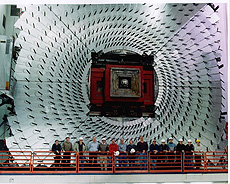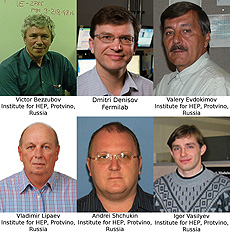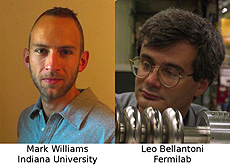Shedding light on forward muons
 |
| The forward muon scintillation counters formed a crucial part of the DZero detector in the Tevatron Run II era (2001-2011). Their characteristic overlapping plates earned them the "fish scales" nickname. Their operation and performance are described in detail in a recent publication.
|
Disponible en español
The DZero experiment, like all such general-purpose particle detectors, is built from a number of distinct subsystems, each designed to perform a specific task. One such component is the muon system, which forms the outermost layer of the detector. Its job is to identify muons from proton-antiproton collisions and measure their trajectories and timing information for use in both the trigger and the subsequent event reconstruction.
In fact, the muon system is itself divided into two complementary parts: three muon tracking layers and three interleaved layers of muon scintillators. The tracking layers provide precise information about the location of muons as they leave the detector, which is used to build the trajectories. The scintillators measure the times that the muons pass through, with excellent precision of less than 1 nanosecond. Together, this is all the information necessary to fully reconstruct muons in the event. A recent limited-authorship publication describes the performance of the muon scintillator counters in the forward region, demonstrating both the excellent performance and the methods used to monitor the system.
Each layer of forward muon scintillator counters forms an overlapping ("fish-scaled") set of aluminum-covered plastic plates, which produce a burst of visible light photons when a muon passes through. This light is then fed into photon counters and converted to an electric current. Because the detection medium is light-based, the information is available very soon after the initial proton-antiproton collision and is hence used to make a decision about whether or not to save (trigger) the event for later use. Triggering is essential to select the roughly 100 events per second that can be saved to tape, out of the several million proton-antiproton collisions in this time.
The timing information is also essential for identifying muons from cosmic-ray sources, which must be removed from the data sample. If a cosmic muon passes directly through the detector, it can look much like a pair of muons originating from the center. However, it will hit the top of the detector around 30 nanoseconds before the bottom, while a genuine muon pair produced in the collision will arrive at the muon system concurrently. By using appropriate timing windows, cosmic-ray muons can be almost completely eliminated from the data without significant reduction of signal efficiency.
Scientists measured the performance of the forward muon scintillators regularly using a variety of independent methods. The efficiency of the light collection components was tested on a daily basis using built-in LED sources. The scintillating plastic plates were tested with radioactive beta ray (electron) sources. The overall performance of the full system was also tested using reconstructed muons identified by the muon tracking system. All methods show consistent results: a very slow reduction in the signal sizes over time, expected due to the effects of radiation aging. This slow change was anticipated during the detector design and had no effect on the muon identification efficiency.
Overall, the detector performed very well during its entire life, with typically over 99.9 percent of counters working during data collection, and its excellent design provided extended spatial coverage and outstanding trigger capabilities.
—Mark Williams
 |
| These DZero members all made significant contributions to this publication. |
 |
| This week sees a transition in the DZero Frontier Science column authorship. Mark Williams is leaving, after 10 months as author, to start a CERN fellowship. He will be replaced by Leo Bellantoni, the head of the Fermilab group at DZero. We thank Mark for his excellent work over the past year. |
|